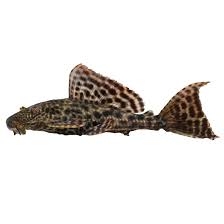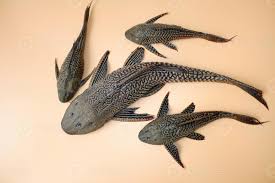The suckermouth catfish remains popular within the aquarium trade due to its fascinating behaviours and environmental benefits. Its historical use as a display aquaria cleaner tells you its more than just a great pet fish. I hope to provide valuable guidance for all who are interested by outlining its habits, habitat, nutrition and care considerations.
What is a Suckermouth Catfish?
The plecostomus cat fish, colloquially known as suckermouth and “pleco,” is one of the more robust marine fishes obtained from freshwater waters. It is a member of the Loricariidae family and inhabit rivers and streams in southern America. This fish is well known for its distinctive shape, which includes a slender torso and sucker mouth, as well as its adeptness in clinging to surfaces. Most aquarists appreciate a pleco for its ability of cleaning algae from the aquaria.
Algal feed on bottom feeder suckermouth catfish are more common than other forms selling nowadays.
Unique Characteristics of the Suckermouth Catfish
Like with most species of catfish, its distinctive feature is a suckermouth which assists stability in holding onto rocks and glasses during water currents. The body is also covered with bony plates to prevent easily succumbing to predation. Most individuals are brown or black with intricate patterns though colours do vary from species to species.
Although some plecos can grow up to 24 inches in length, this impressive size allows them to survive in a wide range of environments. However, in aquariums, they typically remain smaller. As a result, their reduced size makes them ideal for smaller tanks.
Their life span is 10 to 15 years with proper care.
Natural Habitat and Distribution
Suckermouth catfish are adapted to freshwater environments. They are located in rivers, streams, and floodplains throughout the Amazon Basin. The waters where plecos are found are warm and highly vegetated. These fish prefer tranquil waters that are either slow-moving or stagnant and often conceal themselves among rocks, submerged branches, or algae.
Wild Environmental Requirements
- Water Temperature: 75°F to 82°F
- pH Levels: 6.5 (slightly acidic) to 7.5 (neutral)
- Substrate: Sandy or muddy bottoms

Moreover, their presence enhances environmental balance, as they actively contribute to the ecosystem by controlling algae growth.
Aquarium keepers should strive to provide these conditions to support the well-being of their plecos.
Popular Suckermouth Catfish Species
Over 1,000 species exist in the Loricariidae family. Below are some commonly found in aquariums:
1. Common Pleco (Hypostomus plecostomus)
This species is very accessible in pet shops. Due to its large maximum size, it requires spacious tanks.
2. Bristlenose Pleco (Ancistrus sp.)
This species is shorter and has bristle-like growths, making it more suitable for smaller tanks.
3. Clown Pleco (Panaqolus maccus)
This species captures attention from fish breeders and aquarists due to its distinctive coloration that ranges from light to dark stripes, giving the clown pleco a unique appearance.
4. Zebra Pleco (Hypancistrus zebra)
Itaku’s highly black and white striped swim bladder makes it one of the more popular fishes found in town ganters fishes are unique to their breed.
In your search, it is best to check your own tank size and your preferences on what striking species you want.
Feeding and Nutritional Habits
The suckermouth catfish is primarily a herbivore having algae as the main component in its diet. But for these fish, the term “algae” is broad since they’re opportunistic feeders. Their dietary requirements do play an important role in their overall health.
Feeding Suckermouth Catfish
Algae
As mentioned, these fish do graze over algae and inturn help clean the fish tank.
Vegetables
They can enjoy food like zucchini, cucumber and spinach. Steam them for soft digestion.
Pellets and Wafers
Feeding them sinking algae and shrimp wafers would be beneficial as they are made for bottom feeders.
Occasional Protein
Once in a while plecos may have bloodworm or brine shrimp.
Good care devices probably do work well. Make sure to feed them enough food that they can consume within a few minutes.
Setting Up the Ideal Tank Environment
To set up an ideal home for a suckermouth catfish, meticulous care is necessary. The fish can grow large, so the tank setup needs to correspond to their size and behavior. Here are some essential considerations.
Tank Size
Pleco species largely dictate size. For common pleco species, a 75-gallon tank will suffice. A bristlenose will thrive in a smaller, 30-gallon tank. Always choose a larger tank if available, as these fish need room to swim and grow.
Water Conditions
Be sure to maintain a consistent temperature between 75°F and 82°F.
Given the significant waste plecos produce, investing in a good quality water filter is essential.
Regular water changes are crucial to maintain optimal pH and remove toxins in the water.
Tank Features
Like in the wild, be sure to include rocks, driftwood, and plants. Many pleco species also eat driftwood, which makes it excellent. Remember not to add any sharp objects into the tank, since they can injure the fish.
Lighting
Therefore, it’s best to avoid strong lighting, as excessive light encourages undesirable algae growth, which can ultimately disrupt the balance of the tank.
If given proper care, your plecos will not only thrive but also boost the overall health of your aquarium.
Behavior and Social Compatibility
Suckermouth catfish are generally non-aggressive and serene while remaining toward the bottom of the aquarium. As an exception, it’s possible for them to become somewhat territorial, especially in the case of two males sharing the same space.
- Tankmates
Other non-aggressive fish that can share the same habitat include:
- Tetras
- Gouramis
- Corydoras
Avoid keeping plecos with more aggressive fish like cichlids. Conflicts are certain to occur. Providing hiding places helps to limit territorial aggression.
Activity Patterns
Since plecos are nocturnal by nature and most active at night, providing caves and shaded areas helps support their natural behavior without disturbing other fish.
Common Challenges in Suckermouth Catfish Care
As hardy as they may be, plecos face a number of challenges. Care and attention are crucial to correct issues.
1. Algae Growth Over Control
For all their strengths, plecos do not take care of algae growth entirely. Supplement with scrappers or UV sterilizers.
2. Population Control
Overcrowding is an all-to-real issue. Cramming too many fish into a tank causes stress and worsens water quality. Keep the stocked numbers reasonable.
3. Health Concerns
Fatigue or cloudy eyesight can be symptoms of bad water conditions or lack of adequate nutrition. Consistent cleaning of the tank will fix a majority of issues.
Knowing these challenges goes a long way in alleviating stress, ensuring your fish stay healthy and lively.
Why Are Suckermouth Catfish Popular?
One of the reasons for the suckermouth catfishes’ popularity is their upkeep of an aquarium. Through their process of eating algae, these fish cut down the time needed for manual cleaning. Furthermore, their unusual form adds to the visual charm of any tank. These fish are friendly so they do well in community tanks.
Educators and parents alike have complimented their use as teaching tools for toddlers and learners. Their behavior reveals a great deal about aquatic life, therefore helps in understanding ecosystems.
Combining factors of their low-maintenance nature along with its practicality serves to access their popularity from both seasoned and novice aquarists.
Final Thoughts and Care Tips
The freshwater tank enthusiasts will appreciate the suckermouth catfishes, particularly due to the fact they are excellent all-rounded fish. Moreover, they are easy to care for as long as they are given the right attention, food, and space. Although it’s important to have appropriate care guidelines to keep them healthy.
Let’s quickly summarize notable pleco care tips: Select a species suited for your tank dimensions. Observe water conditions: cleanliness and water parameters need regular testing. Give a well-balanced diet including algae, some vegetables, and limited animal protein. Include shelters as well as food sources like caves and driftwood.
Adhering to these tips will allow you to enjoy the numerous advantages of having a Suckermouth Catfish and help maintain equilibrium in your aquarium ecosystem.
READ MORE; emapsite….






